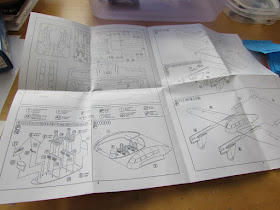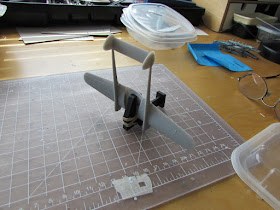https://wingsofintent.blogspot.com/2018/07/american-shelton-ag-4-crusader-avis.html
Congratulations to AVIS for issuing this wonderful plane, a futuristic design that is not as well known as it should be.
A civil subject, an affordable price, and a bold and attractive design.
Well done, AVIS!
It's difficult to recognize the future when it is in the present. This was the 30's!!.
As with other many cases in aviation history (and History at large), the American (Shelton) AG-4 Gyro Crusader arrived too soon.
Eight years ago, attracted by its aspect, between futuristic and comic book, I made a scratch-built model of the AG-4 Gyro, thinking that there was no chance that any manufacturer would ever issue a kit of it.
I am glad I was proven wrong, so others can enjoy the incredibly modern looks of this remarkable plane, created in 1933 and flown in 1935.
My scratch of 10 years ago is here in the blog:
https://wingsofintent.blogspot.com/2014/07/scratch-built-172-american-shelton-ag-4.html
Here a clip of its test flight:
https://www.youtube.com/watch?v=x1xifECLKFc
I will quote myself from that build of long ago:
"The retro-futuristic look and curvaceous, graceful lines of the Shelton American Gyro Crusader whisper in your ear “streamlining” and “teardrop”.
To anyone familiar with the Bauhaus school of design it wouldn’t be a surprise if this one would have come up from their workshops, but it didn’t.
It is actually an American design –many of you already knew it, since the answer is in the question- that had the misfortune of seeing the light of day in the hard post-depression years.
Nevertheless the one and only machine built attracted a lot of publicity, the attention of the general public and some remarkable personalities, Amelia Earhart among them.
During its life the Crusader had some changes in its landing gear and props and also in the variety of images applied mainly to its nose. In some images its surfaces seem to appear without any inscriptions or images, though. A good reference is: "Crusader: The Story of the Shelton Flying Wing" by Alexander Roca."
So we have now the Avis kit in what it came to be known as short run technology.
It has, as we all know, its pros and cons. We get those models unlikely to be cater for by the industry giants at an -in general- reasonable price, and we have to deal with something that occupies our modeling skills in a perhaps more demanding and certainly less complacent manner, cleaning flash, refining parts, dealing with the lack of locating devices and some vague fit.
So be it.
Resealable bag, I like that:
Parts' array:
Masks included:
Decals (will talk about them later):
Transparencies. Fair, if not precisely crystalline. The customary bath in floor polish will take care of it to some degree:
The limitations of the media, but nothing a modeller can't deal with...with some skill and patience:
Some cleanup is ahead...
Instructions, well printed, in good paper, with a few vague points:
Transparencies cleaned, washed, given some floor polish:
The coffee mesh in which all those parts, especially the very small ones, are washed after the cleanup. Do not lose them!:
Parts cleaned up. And man do they need cleanup:
Not the sharpest of molds:
Again, the fixes seem easy enough:
The engine fronts also need a serious cleanup. Not sure if they attempted here to represent the things behind the openings, or these are just plastic blobs.
In any case I will open those up and simulate the engine inside:
Interior is easily assembled:
I carved out the openings:
The wheels need their centers drilled:
You may have to thin the wheels a bit for the nacelle sides to close:
I discarded the exhaust stack since I will use micro-tubing here:
I have seen a number of photos of the Gyro with the flaps down, so I thought it would give the model a little extra pizazz:
Flaps are cut off. The excised parts are not to be used, they need replacement with a proper flat sheet and ribs, to be made later:
The top and lower wing halves are glued together:
Nacelles glued together too:
Flap arrangement ready:
Of note:
The plane, as many prototypes, went through a few modifications and changes in the motifs applied to the nose.
Look at photos to depict the correct decoration with the proper details, since:
-The kit provides four mass balances, but depicts only two on the instructions -for the ailerons-. The other two are seen in photos under the elevator, or on the external sides of the rudders, or both.
-There are elevator control cables running from the aft fuselage to the control horns, not shown on the instructions.
-The back side of the props was 2/3 painted anti-glare black, not shown on the instructions.
-In some photos, rudder tabs can be seen added.
-As provided, the "crusader" image on the decals is missing the legend "American Gyro Crusader" on the top line, and "Denver, Colo." on the bottom line, all in white.
-The booms had airscoops on top after the engines, missing in the kit, but easily fabricated.
-As mentioned, other logos were applied to the plane instead of the "crusader" image on the nose.
A resemblance of the engines is made and inserted into the nacelles:
The props are given the missing axle:
The front of the nacelles is glued:
The nacelle sub-assemblies are glued to the wing. These are handed components, so be sure to do it right (or left, whichever the case, I most definitely prefer left). The fit is fair, but no perfect, so a few touches here and there will help.
The boom/nacelle joint is unfortunately a butt join, and alignment is left here to chance or your eyeball-o-meter, so be careful there. The booms/stab joint, on the other hand, has -miracle!- locating devices:
It's been mentioned that many photos show six mass balances, two under the ailerons, two under the elevator, and two on the external sides of the rudders.
The kit provides four, and shows on the instructions only the two under the ailerons.
So here is how you could make mass balances:
Sand a cone on a styrene rod and chop:
Insert on tube of adequate diameter exposing the front:
Sand it round:
put it aside:
After making several masses prepare the stems, in this case a fine strip:
Glue together:
Make a bunch, chose the best:
In this case this is the size needed:
I got a somewhat self-inflicted issue with the booms: if I aligned the booms at the top flush with the nacelles (which I did), the "karmans" (the part that help merge the two volumes, wing and boom) did not align. This is due to the nacelles' top not seating properly on the wing as molded. If you want to avoid this issue, you will have to either sand the part of the nacelle that seats on top of the wing's trailing edge, or deepen the area on the wing for it to seat lower. So be it, I can deal with that with some putty.
You are warned.
Once I trued the not very good ends of nacelle and booms, I glued the booms. After half a minute or so, I inserted the stab between them (it's a good thing the stab is keyed, otherwise the whole assemble would have been doomed).
Before the glue completely sets, alignment can be taken care of:
The lines start to emerge:
The interior is given the base color:
Interior almost ready, inst. panel decal on the side:
Interior ready, with inst. panel and belts already on, but guess what...
Of course the fuselage halves won't close, you will have to trim the floor a tad fore and aft, and the top of the aft bulkhead.
And this is so with 90% of kits. You think manufacturers may have realized it by now, same for resin aftermarket bits:
Bubble now closed:
But before adding it to the frame, better deal with all those little spots first, easier now than when the bubble is added:
Primer applied:
After some tidying-up the airframe is offered to the bubble, but the fit was found to be poor, plus the clear plastic is riddled at the bottom edges with excrescences that need further clean up.
This will need quite an amount of attention to make for a neat fit, being careful not the fill the bubble from underneath with dust or burrs. Humbag:
After cleaning the interfering areas, the fit still was not good. I think the floor gets in the way somehow, so I scrapped-down the wing center section a bit. Still, only under duress would the bubble fit, so 5 min. epoxy was used to glue it. I don't recommend my method, you risk to crack open the bubble middle seam, and then you will be in trouble. It worked here, fortunately:
The epoxy seen on the Karmans is actually under the clear part, not above:
Time to put the masks on. Then a coat of primer to see where the issues are, which is very difficult with the clear parts otherwise:
The Crusader had two very visible aircoops on the boom spines after the engine, a bit offset outwards. The kit missed that.
And in case you feel tempted to represent the plane with its latter retractable landing gear, an additional bump in the form of an elongated blister would then be visible after the airscoop:
A light coat of primer is applied:
The somewhat tedious job of spotting blemishes and correct them between light passes of primer:
More priming and some base colors:
Finally the black base coat is applied:
Props' blades anti-glare black backs are masked and polished aluminium applied:
Copper paint airbrushed. A gloss coat will follow:
Clear coat on and masks off. The masks behaved very well. Now the remaining tasks of adding two elevator control cables, the Pitot probe, props, nav. lights and decals:
The new exhaust pipes, made of brass tube. An angle is sanded, and then the piece is cut off, and then repeat eight times:
Some of the decals on. The kit's decals have solid color and are very, very thin, which is superb.
The other side of that coin is that they fold on themselves at the least provocation. Beware.
The exhaust tubes are in place. Later they will be painted:
Since the kit's nose decals were missing relevant white lettering, I commissioned from Arctic Decals a small set of substitute images, seen also in photos. Two go on both sides of the nose and two on the rudders. They are not mirrored, but are the same image:
Completed model here:
https://wingsofintent.blogspot.com/2018/07/american-shelton-ag-4-crusader-avis.html









































































You beat me to it again!- Nice work as always.
ReplyDelete;-)))
Delete